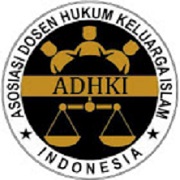Submissions
Author Guidelines
The Author Guidelines of Journal of Family Law and Islamic Court (Cambria 14pt Bold)
Muktashim Billah*) (12pt bold)
Department of Ahwal Syakhsiyah, Faculty of Islamic Studies, Universitas Muhammadiyah Makassar, Jl. Sultan Alauddin No.259, Makassar, Indonesia 90221 (11pt normal italic)
Abstract (Cambria, 12pt Bold)
This is a new author guidelines and article template of Journal of Family Law and Islamic Court since year 2022 publication. Article should be started by Title of Article followed by Authors Name and Affiliation Address and abstract. This abstract section should be typed in Italic font and font size of 11 pt and number of words of 150-250. Special for the abstract section, please use left margin of 25 mm, top margin of 30 mm, right and bottom margins of 20 mm. The single spacing should be used between lines in this article. If article is written in Indonesian, the abstract should be typed in Indonesian and English. Meanwhile, if article is written in English, the abstract should be typed in English only. The Abstract is a miniature contents of the entire writing statement, comprise : problem, purpose, method, scientific finding results, and short conclusion. The abstract should only be typed in one paragraph and one-column format.
Keywords: author guidelines; JFLIC; template
Abstrak (Cambria, 12pt Bold)
Petunjuk ini merupakan petunjuk baru untuk penulisan dan submit artikel Journal of Family Law and Islamic Court, mulai penerbitan tahun 2022. Artikel yang dipersyaratkan harus diawali dengan Judul Artikel, Nama Penulis, Alamat Afiliasi Penulis, diikuti dengan abstrak yang ditulis dengan huruf miring (Italic) sepanjang 150-250 kata. Khusus untuk Abstrak, teks ditulis dengan margin kiri 35 mm dan margin kanan 30 mm dengan ukuran font 11 pt dan jenis huruf Cambria serta jarak antar baris satu spasi. Jika artikel berbahasa Indonesia, maka abstrak harus ditulis dalam bahasa Indonesia dan bahasa Inggris yang baik dan benar. Jika artikel berbahasa Inggris, maka abstrak harus ditulis dalam bahasa Inggris saja. Bagian Abstrak merupakan miniatur isi dari keseluruhan tulisan, meliputi masalah, tujuan, metode, hasil, dan simpulan. Abstrak untuk masing-masing bahasa hanya boleh dituliskan dalam satu paragraf saja dengan format satu kolom.
Kata kunci: petunjuk penulisan; JFLIC; template
1. Introduction
Journal of Family Law and Islamic Court, is a journal published twice a year in February and August by the Department of Ahwal Syakhsiyah, Faculty of Islamic Studies, Universitas Muhammadiyah Makassar. It aims to publish conceptual article, review article, and research article in the field of Governmental Science and its related issues.
Journal of Family Law and Islamic Court, have been reviewed by peer reviewers. Starting from 2022, Journal of Family Law and Islamic Court, only received articles from original findings (main priority), and new scientific review articles (non-priority) (Bekker et al., 1999; Bezuidenhout et al., 2009). The decision on whether the scientific article is accepted or not in this journal will be the Editorial Board’s right based on peer reviewers’ recommendation (Bhaktavatsalam & Choudhury, 1995).
2. Title, Name and Author’s Address
Article title, author's name (without academic degree(s)), and author's affiliate address are written in the center on the first page under the article title. The distance between title and author's name is double-spacing; meanwhile the distance between author's affiliate address and abstract title is single-spacing. Keywords should be written under abstract for each language. It is arranged alphabetically and separated by a semicolon consisted of 3-5 words. For Indonesian article, the title is translated into English at the beginning of English abstract (see the example above).
Corresponding Author should be marked with an asterisk and followed by a comma "*)" as the example above. At the bottom of the left column on the first page/abstract, it is written the Corresponding Author’s mark and his/her email address (see example). Article revisions and final decisions will only be communicated through the Corresponding Author’s email.
If there is more than one author, write the authors’ names separated by a comma (,). If the author's name consists of two words, the first name should not be abbreviated. If the author’s name consists of only one word, write his/her actual name in one word. However, the online version (HTML) will be written in two words consisting of the same name (repeatedly) for metadata indexation purpose (Camdali & Tunc, 2006; Fridman, 2008).
3. Guidelines for Writing a Manuscript
Manuscript complying with the writing instructions for Journal of Family Law and Islamic Court (using MS Word format and this article’s template) should be submitted online at the following URL (if there is a difficulty in submitting the manuscript online, please contact email: jflic@unismuh.ac.id):
----------------------
Submitting manuscript using Online Submission System at Journal of Family Law and Islamic Court
(http://journal.unismuh.ac.id/index.php/jflic) after registering as an Author in the "Register" menu.
---------------------
Guidelines for Writing Article and template can be downloaded at the following address:
- Template and Guideline for Writing Article in MS Word (.doc): here
The instruction on submitting manuscripts online can be seen in Guidelines for Online Submission below. Manuscript does not comply with the writing instructions for Journal of Family Law and Islamic Court, your script will be returned to the author before being reviewed.
Manuscript must consist of the following scientific article components (subheadings in sequence), i.e.: (a) Article Title, (b) Author's Name (without title), (c) Author’s Affiliate Address, (d) Abstract and Keyword, (e) Introduction, (f) Research Methods, (g) Results and Discussion, (h) Conclusion, (i) Acknowledgment, and (j) References.
Manuscript can be made in Indonesian or English with a maximum of 25 pages including figures and tables. Manuscript should be written according to this article template in a ready-to-print form (Camera ready). The article should be typed with A4 (210 x 297 mm), left margin of 25 mm, right margin of 20 mm, bottom margin of 20 mm, and top margin of 30 mm. Manuscript should be written using Cambria, 12-point font size (except article title, author's name and abstract title), single-spacing, and two-column format (except article title, author's name, and abstract). The distance between columns in this article is 10 mm.
Foreign words or terms are used in italics. Author is expected to avoid using foreign terms for Indonesian article. The new paragraph is written 10 mm from the left margin, and there is no space between paragraphs. All numbers are written using Arabic numerals, except at the beginning of a sentence.
Table and Figure are placed in a group of texts after the table or figure is referenced. Each figure should be given a title (Figure Caption) and placed at the bottom of the figure. It is numbered using Arabic numerals and followed by the figure title. Each table should be given a title (Table Caption). It is numbered using Arabic numerals at the top of the table and followed by the table title. Figure is able to be printed clearly (font size, resolution, and line size). Figure and table and diagram/schema should be placed according to column between a group of texts or in the middle of the page if it is too large. Table should not contain vertical lines, meanwhile horizontal lines are allowed for the important ones.
4. Guidelines for Writing the Contents of an Article
Article Title: Article title should be written briefly and clearly. It shows exactly the issue to be discussed and should not create misinterpretations. Article title is written in capital letters symmetrically and does not contain unusual abbreviations. Express the main idea of a new article and followed by another explanation.
Introduction: Introduction consists of (in sequence) general background, state of the art as the basis for the scientific novelty statement of the article, scientific novelty statement, and research problem or hypothesis. In the end, introduction should mention the purpose of article review. Literature review is not allowed in the scientific article format, so it is replaced by the state of the art to prove the novelty of the article.
Research Methods: Method is implemented to solve problems, including analytical method. The method used to solve the research problems is described in this section.
Results and Discussion: This section consists of results and discussion. Every result should be supported by sufficient data. Then, result should be able to answer the research question or hypothesis stated earlier in the introduction.
Conclusion: Conclusion states the answer of the hypothesis and/or research objective or scientific finding. Conclusion is not the repetition of findings and discussion, but it is the summary of findings as expected in the objective or hypothesis. If necessary, conclusion can also be ended with the next idea to be implemented to the study.
Acknowledgment: Acknowledgment are primarily addressed to research funders or donors. Acknowledgment can also be dedicated to people who contribute in the study.
References: All references used in the article should be listed in the References section. References should contain reference literature originating from primary sources (scientific journals at least 80% of the entire references) published in the last 10 (ten) years. Each article contains at least 10 (ten) references. It is better to write the reference system in the article and in the references section using the reference management programs such as Mendeley, EndNote, Zotero, or others.
5. Guidelines for Writing Citation/Reference in an Article
Author should write the sources when (s)he uses data or cites statements from other literatures. Reference or citation is indicated by writing author's name and year (Irwan and Salim, 1998). If there are more than two authors, only the first author's name is written and followed by "et al". (Bezuidenhout et al., 2009; Roeva, 2012). Everything cited in the article should be listed in the References section, and vice versa, everything written in the References should be existed in the article (Wang et al., 2011).
All references used in the article should be listed in the References section. References should contain reference literature originating from primary sources (scientific journals at least 80% of the entire references) published in the last 10 (ten) years. Each article contains at least 10 (ten) references.
6. Guidelines for Writing References
All references used in the article should be listed in the References section. References should contain reference literature originating from primary sources (scientific journals at least 80% of the entire references) published in the last 10 (ten) years. Each article contains at least 10 (ten) references.
It is better to write References using the reference management programs such as Mendeley. The writing format used in Journal of Family Law and Islamic Court is APA 6th Edition (American Psychological Association).
Reference in the form of scientific journal:
Billah, Muktashim (2011). Penjelasan Kompilasi Hukum Islam. Ahwaluna : Jurnal Hukum Keluarga dan Peradilan Islam, 1(1), 1-15.
Reference in the form of Book Title:
Billah, Muktashim (2015). Kumpulan Contoh Hukum Fikih. Jakarta: Gramasurya.
Reference in the form of Seminar Proceedings:
Fang, Q., Zhao, F., & Guibas, L. (2003). Lightweight sensing and communication protocols for target enumeration and aggregation. In M. Gerla, A. Ephremides, & M. Srivastava (Eds.), MobiHoc ’03 fourth ACM symposium on mobile ad hoc networking and computing (pp. 165 –176). New York, NY: ACM Press.
Reference in the form HandBook:
Greisler, David S, Stupak, Ronald J (2007). Handbook of Technology Management in Public Administration. New York: CRC Taylor and Francis
7. Guidelines for Submitting Manuscript Online
Manuscript should be submitted using one of the following ways (the second one is preferable):
- Manuscript is submitted through Online Submission System in Journal of Family Law and Islamic Court
(http://journal.unismuh.ac.id/index.php/jflic)
- First, author registers as Author and/or Reviewer (check the role as Author and/or Reviewer) in the "Register" menu or the address:
http://journal.unismuh.ac.id/index.php/jflic/user/register
- After the author logins as Author, click on "New Submission". There are 5 steps to submit an article, i.e.: (1). Start, (2). Upload Submission, (3). Enter Metadata, (4). Upload Supplementary Files, (5). Confirmation
- In the Start menu, select Journal Section (Full Article) and check all checklists.
- In the Upload Submission menu, upload the manuscript file in MS Word.
- In the Enter Metadata menu, enter all Authors and affiliates data and followed by title, abstract, and indexing keywords.
- In the Upload Supplementary Files menu, the author is allowed to upload supporting data files or cover letters or other documents.
- In the Confirmation menu, click "Finish Submission" if all data is correct.
- If author finds difficulties in sending manuscript via online system, manuscript can also be sent via E-mail to the editorial team of Journal of Family Law and Islamic Court (jflic@unismuh.ac.id). However, this method is not recommended.
8. Article Processing Fee
Each article submitted to the editorial office of Journal of Family Law and Islamic Court is free of charge including article processing. The publication cost is borne by the journal publisher.
Submission Preparation Checklist
All submissions must meet the following requirements.
- The submission has not been previously published, nor is it before another journal for consideration (or an explanation has been provided in Comments to the Editor).
- The submission file is in OpenOffice, Microsoft Word, RTF, or WordPerfect document file format.
- Where available, URLs for the references have been provided.
- The text is single-spaced; uses a 12-point font; employs italics, rather than underlining (except with URL addresses); and all illustrations, figures, and tables are placed within the text at the appropriate points, rather than at the end.
- The text adheres to the stylistic and bibliographic requirements outlined in the Author Guidelines, which is found in About the Journal.
- If submitting to a peer-reviewed section of the journal, the instructions in Ensuring a Blind Review have been followed.
Copyright Notice
In the event that the article is received by the Editorial Team of Journal of Family Law and Islamic Court there is a decision to publish the article, the copyright of the article will be transferred to Journal of Family Law and Islamic Court.
Department of Ahwal Syakhsiyah, Faculty of Islamic Studies, Universitas Muhammadiyah Makassar as the publisher of Journal of Family Law and Islamic Court holds the copyright of all articles published in this journal.
Department of Ahwal Syakhsiyah, Faculty of Islamic Studies, Universitas Muhammadiyah Makassar holds the right to reproduce and distribute the article and author is not allowed to publish the same article published in this journal.
Statement of Authenticity and Manuscript Copyright can be downloaded: here
After filling in the statement letter, please send via e-mail: jflic@unismuh.ac.id











